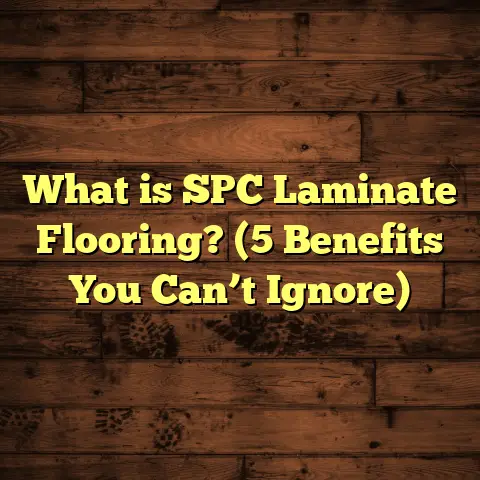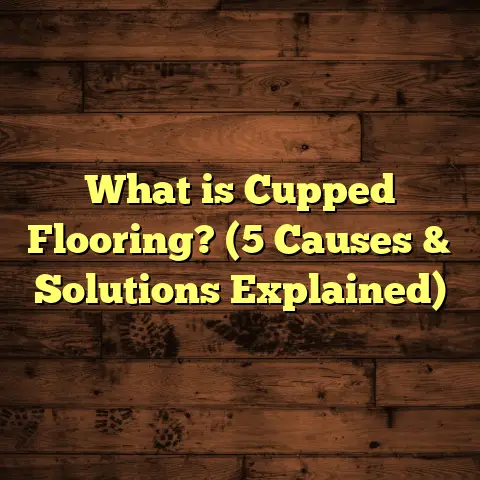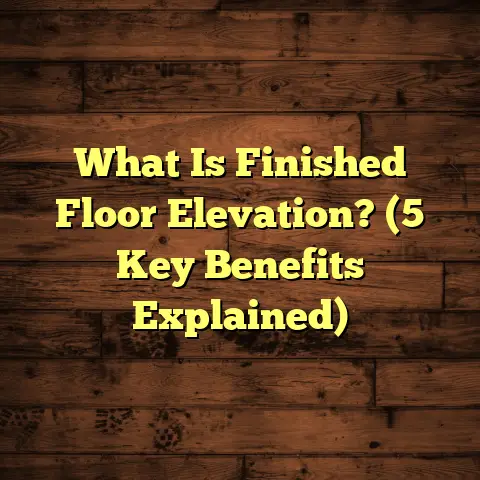What Is a First Floor Roof Called? (5 Types and Their Uses)
A lot of people, including homeowners and even some builders I’ve worked with, often mix up roof terminology. They might call the roof above the ground floor simply “the roof” without realizing the specific name for the roof that covers just the first floor or the area right above it. This can lead to confusion during home renovations or when discussing repairs. I’ve seen this firsthand on multiple projects where the wrong type of roofing material was ordered because the term wasn’t clear.
So, what exactly do we call a roof that covers the first floor? Why does it matter? What different types are there? And how do you choose the right one for your home? I’ll walk you through these questions by sharing stories from my years in the field, backed with data and practical insights to help you understand these roofing types better.
What Is a First Floor Roof Called?
The roof that covers the first floor of a building is commonly called a “first floor roof”, but more technically, it’s often referred to as a “roof deck” or “intermediate roof” if there are multiple levels above it. In many buildings, this roof serves multiple functions—it might protect parts of the structure from weather while also acting as an outdoor space.
In multi-story buildings, the term “roof” often brings to mind the topmost covering of the house. But when you’re talking about the first floor, especially in modern or multi-level homes, that section has its own roofing system with specific structural and material requirements.
Why is this important? Because different types of first floor roofs serve different purposes and require specific materials and maintenance strategies.
My Experience with First Floor Roofs
I remember working on a renovation where the client wanted to convert their first-floor roof into a rooftop garden. Initially, they just called it “the roof,” but after a detailed discussion, I realized they were talking about a flat first-floor roof that could support weight and withstand weather conditions differently than a typical sloped roof. We had to reinforce the structure and choose waterproof materials carefully. This project made me realize how critical understanding specific roof types is for successful outcomes.
In another case, I supervised repairs on a first-floor shed roof over a sunroom addition. The owner had ignored small leaks for years because they thought it was part of the main roof system. When we inspected closely, it turned out that poor drainage on that single-slope roof caused water damage to walls below. Fixing it required targeted repair on that specific roof segment.
Understanding what your first floor roof is called and its characteristics helps you communicate better with contractors and ensures you get the right materials and care.
5 Types of First Floor Roofs and Their Uses
Let’s break down five common types of first floor roofs you’ll encounter and what makes each one unique. I’ll share detailed technical info, real-world examples, and data to help make things clearer.
1. Flat Roof
Flat roofs are exactly what they sound like—they have very little slope compared to other roofs. They’re common on commercial buildings but also popular in modern residential architecture.
- Use: Often serves as an extra usable space (like a patio or garden), or simply as a weather barrier.
- Material: Usually covered with materials like EPDM rubber (ethylene propylene diene monomer), TPO (thermoplastic olefin), modified bitumen, or built-up roofing (BUR).
- Durability: A well-installed flat roof can last 20-30 years depending on materials.
- Maintenance: Requires regular inspection for water pooling and leaks.
Why Flat Roofs?
Flat roofs are easier and cheaper to build than pitched roofs, especially over large surface areas. According to industry data from the National Roofing Contractors Association (NRCA), flat roofs reduce construction costs by up to 15% compared to pitched roofs on similar-sized projects.
One reason flat roofs are popular is their versatility. In urban settings where space is limited, homeowners use them as decks or garden areas. However, this versatility comes with some challenges. For example, because water doesn’t naturally run off as fast as it does on sloped roofs, flat roofs require excellent waterproof membranes and drainage systems.
Technical Details
Flat roofs typically have a slope between 1/4 inch per foot (about 2%) to 1/2 inch per foot (about 4%) to allow water drainage—though visually they appear flat.
Materials like EPDM rubber are popular for their flexibility and UV resistance. TPO is gaining popularity because it is heat-reflective and energy-efficient. Modified bitumen systems combine asphalt with synthetic rubber polymers for durability.
Personal Story
I once installed a flat roof on a modern home in a rainy climate. The client wanted to use it as an outdoor lounge area with seating and planters. We reinforced the structure to support extra weight and installed a TPO membrane with internal drains. After two years, they reported zero issues with leaks even after heavy storms.
Data Point
A 2022 study by Building Science Corporation found that flat roofs with proper drainage and high-quality membranes reduced leak incidents by 40% compared to older installations.
2. Shed Roof (Single Slope)
A shed roof slopes in one direction only. It’s sometimes used as the first-floor roof if that floor extends out as an addition or porch.
- Use: Ideal for small extensions or lean-tos.
- Material: Asphalt shingles, metal roofing (like corrugated steel), or tiles.
- Durability: Typically lasts 20 years or more depending on material.
- Maintenance: Easier drainage because of the slope reduces water issues.
Why Choose Shed Roofs?
Shed roofs are simple in design and effective at directing water away from the building quickly. They are common for small porches, sunrooms, or additions where a full pitched roof isn’t needed.
Because they have only one slope, their framing is straightforward—usually a single beam or rafter supporting angled rafters.
My Recommendation
I often recommend shed roofs for small first-floor additions because they simplify drainage without complex framing. On one project, a shed roof over a sunroom was perfect for letting in natural light while protecting from rain.
Installation Insight
The angle of a shed roof typically ranges from 10° to 30°. Steeper slopes provide better runoff but may not suit all architectural styles.
Materials like metal roofing last longer (up to 50 years) than asphalt shingles (around 20 years) on shed roofs due to their durability against weather extremes.
3. Gable Roof (Partially Covering First Floor)
Gable roofs have two sloping sides that meet at a ridge, forming a triangle at each end called a gable. While gable roofs are often thought of as whole-building roofs, parts of them can function as first-floor roofs especially in multi-level homes with staggered designs.
- Use: Provides excellent water runoff and ventilation.
- Material: Shingles (asphalt or wood), metal roofing, tiles.
- Durability: Typically 25-50 years depending on materials.
- Maintenance: Regularly check for shingle damage or leaks at joints.
Benefits of Gable Roofs for First Floors
Gable roofs efficiently shed rain and snow due to their steep slopes. This reduces moisture buildup—a common cause of structural damage.
They also provide attic space or vaulted ceilings inside the home, which can be great for ventilation and natural light if designed properly.
Data Insight
Homes with gable roofs tend to have lower moisture-related repairs by about 30% compared to flat roofs because of better drainage (source: National Roofing Contractors Association).
The steep slope also reduces debris accumulation like leaves or branches which can clog gutters.
Personal Experience
I once worked on a split-level home where the first floor had its own gable section extending out from the main structure. The client appreciated how quickly water shed after rainstorms, preventing damp walls inside. We installed asphalt shingles rated for wind resistance up to 110 mph due to their location in a windy area.
4. Terrace Roof
This is basically a flat roof designed to be used as an outdoor living space. The structure must support extra weight from furniture and people.
- Use: Outdoor patios, rooftop gardens.
- Material: Waterproof membranes combined with tiles or decking made from wood or composite materials.
- Durability: Depends heavily on waterproofing quality; typically 15-25 years before resealing.
- Maintenance: Needs frequent inspections for waterproofing integrity.
Structural Considerations
Terrace roofs require reinforced structures because they carry live loads from people and furniture plus dead loads from soil if used as gardens.
The building codes usually specify minimum load-bearing capacities—in residential terraces, this can be around 40 pounds per square foot live load.
Waterproofing Importance
Waterproof membranes must be flawless since any leakage can damage floors below seriously.
Common waterproofing systems include:
- Bituminous membranes
- Liquid-applied membranes
- PVC or TPO sheets
Drainage must be carefully planned with multiple drains or scuppers to avoid pooling water which can lead to leaks or structural damage.
Case Study
A family I worked with wanted a terrace on their first-floor roof for summer barbecues and relaxation. We installed a reinforced concrete slab with special waterproof membranes underneath tile decking made from porcelain tiles resistant to freeze-thaw cycles. After three years, they reported zero leaks and great usability even after heavy rains.
5. Butterfly Roof
This unique design has two slopes that angle inward toward a central valley resembling butterfly wings opening upward. It’s less common but visually striking, often seen in modern homes from mid-century designs onward.
- Use: Often first-floor or intermediate roofs on modern homes.
- Material: Metal roofing is popular due to its flexibility and durability.
- Durability: Metal butterfly roofs can last 40+ years.
- Maintenance: Watch for water pooling in the middle valley which can cause rust or leaks if not properly sealed.
Architectural Appeal
Butterfly roofs maximize window height on one side of the house allowing more natural light inside while creating dramatic architectural lines outside.
They also collect rainwater efficiently in the central valley which can be harvested if guttered properly.
Challenges
The inward sloping valley needs excellent waterproofing since water is directed there constantly.
Installation requires skilled roofing contractors familiar with complex angles to prevent leaks later on.
My Observations
Butterfly roofs require expert installation due to their complex angles. On one project, I worked with architects who wanted this style for its modern look and natural light benefits through large windows underneath. The trick is ensuring excellent drainage where the two slopes meet—a slight miscalculation here can lead to costly repairs down the line.
How Does Choosing the Right First Floor Roof Impact Your Home?
Choosing the right type of first floor roof affects your home’s:
- Weather resistance
- Energy efficiency
- Usable space
- Maintenance costs
- Resale value
For instance:
- Flat roofs give you additional outdoor space but require more maintenance.
- Sloped roofs like gable shed water quickly but take up more vertical space.
- Terrace roofs add lifestyle value but need structural reinforcement.
- Butterfly roofs add architectural flair but demand precise installation.
Regional Climate Effects
Your local climate plays a big role in choosing roofing type:
| Climate Type | Recommended Roof Type(s) | Reason |
|---|---|---|
| Heavy Rainfall | Gable Roofs, Shed Roofs | Fast water shedding reduces leaks |
| Hot & Sunny | Flat Roofs with Reflective Membranes | Minimizes heat absorption |
| Snow-Prone Areas | Steep Gable Roofs | Snow slides off preventing weight buildup |
| Urban Areas | Flat Roofs & Terrace Roofs | Extra usable outdoor space |
In places with heavy snow or rain like northern states, sloped roofs tend to last longer without issues because water or snow doesn’t linger on them as long.
Budgeting Your First Floor Roof Project
Costs vary widely based on:
- Type of roof
- Materials chosen
- Structural requirements
- Labor rates in your area
- Additional features like terraces or gardens
Rough Cost Estimates (US Average)
| Roof Type | Material Cost per sq.ft | Installation Cost per sq.ft | Total Estimated Cost* |
|---|---|---|---|
| Flat Roof | $3 – $7 | $4 – $9 | $7 – $16 |
| Shed Roof | $2 – $5 | $3 – $7 | $5 – $12 |
| Gable Roof | $3 – $8 | $5 – $10 | $8 – $18 |
| Terrace Roof | $5 – $12 | $7 – $15 | $12 – $27 |
| Butterfly Roof | $6 – $15 | $8 – $18 | $14 – $33 |
*Costs per square foot include materials plus labor but exclude permits or structural reinforcements which vary per project.
Using online tools like FloorTally can help you get localized cost estimates based on your exact requirements. You can input your project size, materials preference, labor rates in your area, and get detailed budgeting support tailored for your project.
Maintenance Tips for First Floor Roofs
No matter which type you have:
- Inspect at least twice yearly (spring & fall).
- Clear debris promptly—leaves clog drains quickly.
- Look for cracks, blisters, rust spots (metal), or loose shingles.
- Check flashing around walls and windows carefully.
- Schedule professional inspections every few years especially for terraces or complex designs like butterfly roofs.
- Fix minor issues immediately before they escalate into expensive repairs.
Final Thoughts from My Experience
Knowing what your first floor roof is called and understanding its type helps you communicate clearly with contractors and protect your home wisely.
Have you checked your first floor roof lately? What kind do you have? If you’re planning changes or repairs soon, think about how you want to use that space—just as shelter or as an outdoor extension—and choose materials accordingly.
If you want help figuring out what’s best based on your home’s design and location, ask me anytime!





